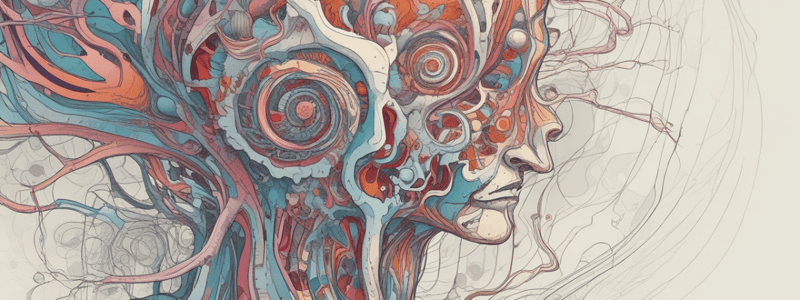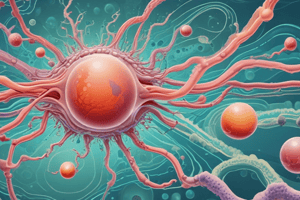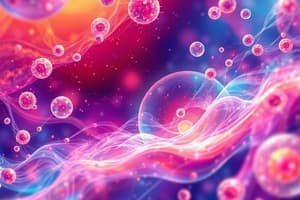Podcast
Questions and Answers
What is the primary function of the heart in relation to red blood cells?
What is the primary function of the heart in relation to red blood cells?
- To pump them around the body so they can do their job (correct)
- To filter out impurities from the red blood cells
- To produce red blood cells
- To help them swim around in the bloodstream
What is unique about the movement of red blood cells in the bloodstream?
What is unique about the movement of red blood cells in the bloodstream?
- They are pumped around the body by the heart (correct)
- They are stationary in the bloodstream
- They are capable of swimming on their own
- They move randomly throughout the body
What is the significance of cell migration and movement in our bodies?
What is the significance of cell migration and movement in our bodies?
- It is only important during development
- It is not important at all
- It is only important for immune system function
- It is critically important for various bodily functions, including development and immune system function (correct)
What is the primary function of the flagellum in sperm cells?
What is the primary function of the flagellum in sperm cells?
What are the microtubule proteins in the flagellum of sperm cells similar to?
What are the microtubule proteins in the flagellum of sperm cells similar to?
What is the significance of cell movement during development?
What is the significance of cell movement during development?
What is unique about the movement of certain cells in our bodies?
What is unique about the movement of certain cells in our bodies?
What is the epic journey of sperm cells towards?
What is the epic journey of sperm cells towards?
What is the function of dynein proteins in sperm cells?
What is the function of dynein proteins in sperm cells?
What is the purpose of a flagellum in a cell?
What is the purpose of a flagellum in a cell?
What is the function of microtubules in the cytoskeletal model of cell movement?
What is the function of microtubules in the cytoskeletal model of cell movement?
What type of cell is used as an example of cell movement in the immune system?
What type of cell is used as an example of cell movement in the immune system?
What is the term for the process of a neutrophil sticking to the endothelium and rolling along?
What is the term for the process of a neutrophil sticking to the endothelium and rolling along?
What is the function of actin proteins in the cytoskeletal model of cell movement?
What is the function of actin proteins in the cytoskeletal model of cell movement?
What is the purpose of the endothelium in the movement of neutrophils?
What is the purpose of the endothelium in the movement of neutrophils?
What is the result of a sperm cell's flagella failing to form properly?
What is the result of a sperm cell's flagella failing to form properly?
What is the term for the cell 'skeleton' that makes up its structure?
What is the term for the cell 'skeleton' that makes up its structure?
What is the name of the signal that attracts neutrophils to areas of the body that need their help?
What is the name of the signal that attracts neutrophils to areas of the body that need their help?
What is the function of microtubules in cell movement?
What is the function of microtubules in cell movement?
What is the main difference between the two types of endocytosed vesicles in the membrane flow model?
What is the main difference between the two types of endocytosed vesicles in the membrane flow model?
What happens to the plasma membrane during the membrane flow model of cell movement?
What happens to the plasma membrane during the membrane flow model of cell movement?
What is the role of integrins in the membrane flow model?
What is the role of integrins in the membrane flow model?
What is the cytoskeletal model of cell movement?
What is the cytoskeletal model of cell movement?
What happens to the fixed microtubules in the cytoskeletal model?
What happens to the fixed microtubules in the cytoskeletal model?
What is the net effect of the membrane flow model on cell movement?
What is the net effect of the membrane flow model on cell movement?
What is the purpose of the exocytosis of vesicles in the membrane flow model?
What is the purpose of the exocytosis of vesicles in the membrane flow model?
Flashcards are hidden until you start studying
Study Notes
Cell Movement
- Cell movement is crucial in our bodies, especially during development and immune system function.
- Some cells, like red blood cells, are pumped around by the heart, while others, like sperm cells and white blood cells, can move on their own.
Sperm Cell Movement
- Sperm cells have a flagellum, a tail that whips back and forth to propel them forward.
- The flagellum is made of microtubule proteins and dynein proteins, similar to a Lego structure.
- Flagella are also found in bacteria and archaea, but with different proteins.
- Proper flagellum formation is essential for sperm to reach an egg for fertilization.
White Blood Cell Movement
- White blood cells, like neutrophils, move around the bloodstream until they receive a signal to help with infections.
- They respond to the signal by sticking to the endothelium, rolling along, and then moving between endothelial cells into the tissues.
- Their movement is critical for reaching areas of infection.
Cytoskeleton and Cell Movement
- A cell's cytoskeleton, composed of proteins, provides its structure and enables movement.
- There are two theories for cell movement: the cytoskeletal model and the membrane flow model.
- The cytoskeletal model proposes that:
- Actin proteins polymerize at the leading edge of the cell, pushing it forward.
- Microtubules at the back of the cell act as a rudder to steer and as an anchor to stop movement.
Membrane Flow Model
- The membrane flow model proposes that:
- Bits of plasma membrane are internalized as vesicles and move to the front of the cell to exocytose.
- There are two types of vesicles: those with just plasma membrane (extending the leading edge) and those with integrin proteins (anchoring the cell).
- The combination of these vesicles enables cell movement.
Studying That Suits You
Use AI to generate personalized quizzes and flashcards to suit your learning preferences.




